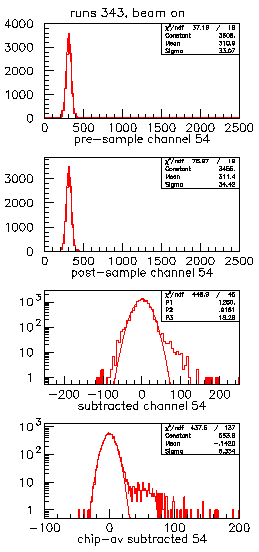
|

-
pre-sample:
distribution of ADC values for channel 54 taken just
before the event occurred.

-
post-sample:
distribution of ADC values for for the same channel,
taken 400 nsec later, just after the event.
Note the widths of the pre- and post-samples are 34 channels.

-
post-pre difference:
note the width is 18 channels, which is less than the
pre- and post-sample widths.
--> Low-frequency noise (slow on the scale of 400 ns) moves the
pre- and post-samples in unison. This noise is removed by the
subtraction. Still, the remaining smearing is too broad to separate
the pedestal (actually the difference between pre- and post- pedestals,
therefore sitting at exactly 0.0) from the signal,
expected in channel 50.

-
chip-by-chip subtraction:
From staring at the raw data, it seemed
channels moved up or down in groups of 8 channels. Apparently, noise is
injected on the ADC chip-by-chip level. To remove this noise, take the
average of the signals on a chip (except for the most extreme value, and
subtract this from each value. Now the signal stands out. Width is 8.3
channels.
|



